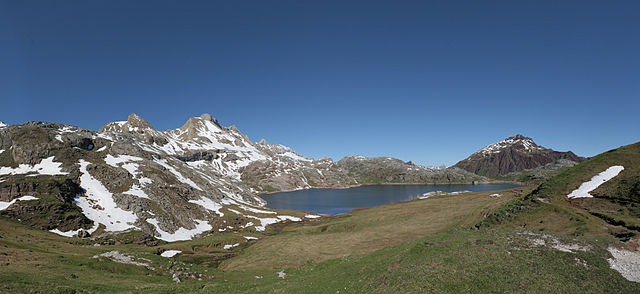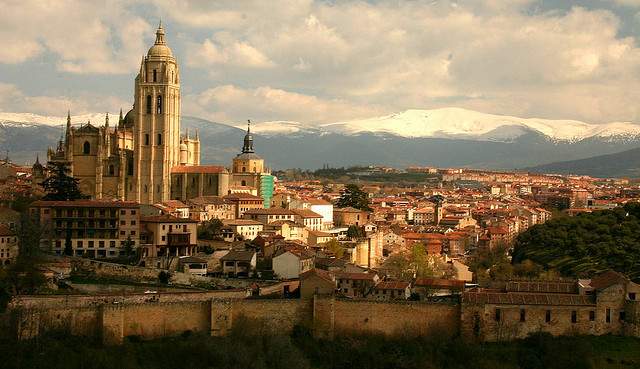Thinking of planning a RTW trip and adding Spain to the itinerary? Don’t know where to start? Sign up today for Plan Your RTW Trip in 30 Days and start receiving email lesson plans tomorrow – it’s free! You’ll be on the road before you know it!
![]()
Spain is as diverse as it is stereotypical. A land of passion, food, art, and music, where the population is dedicated to living the good life and appreciating every moment of it, you will never be disappointed whether you are visiting the bustling metropolitans of Barcelona or Madrid, or escaping to the high mountains for a little R&R.
We chose the $55 per person, per day number after personal experience and research. From dormitories to private rooms, hotels or high-end resorts, accommodation is easy to find. Unfortunately Spain is not the cheapest place out there; however, the rewards of an awesome nightlife, food, culture, and great activities is well worth the extra cash. Hostels are by far the easiest way to save on accommodation, unless you are traveling in a group. In that case, websites like AirBnB can make it much more affordable to find an apartment to share with your friends. In this situation, you can also save a little bit by visiting local grocery stores and cooking at home. Don’t worry, el vino de la mesa is cheap, delicious, and easy to find! A dorm usually ranges between $15-30 USD per night, always includes sheets, and most of the time has shared common areas and free Wi-Fi. This budget also assumes that public buses will be your main mode of transportation.
A land of passion, food, art, and music, where the population is dedicated to living the good life and appreciating every moment of it.
Spain’s diverse geography means one thing when it comes to cuisine: lots of flavor, lots of ingredients, and lots of different dishes. Whether it’s fresh seafood on the coasts, tapas in local bars in the city centers, or a taste of the regional dish paella, your taste buds will not be wanting. The foods of Spain differ regionally, so depending on where you are, you will experience some new combination of flavors. Regardless of where, though, the passion that Spaniards have for food, and the conversations you have over the dinner table will be memorable.
When it comes to activities, I didn’t say “No” to anything because of cost – I experienced everything there was to experience. From exploring Barcelona’s diverse city streets, art museums, and vibrant nightlife, to hiking in the Sierra Nevadas, the suggested $55/person/day budget will allow you to do tons of things. Following is a breakdown of how you, too, can travel around Spain on $55 per day, and we’ll offer tips, advice, and practical information for those of you who want to do it on less and more than that.
Need help planning a RTW trip? Let us help by signing up for Plan Your RTW Trip in 30 Days

Transportation
The transportation infrastructure in Spain is fast, efficient, clean, and surprisingly affordable in comparison to some of its European neighbors. You will find luxury buses connecting most major cities, both nationally and internationally. There is an intricate train system that connects most of the country, from smaller towns to major transport hubs. Europe in general has several different cheap airline options, so that is also an option to consider, especially if you are rushed for time. Private cars are available for hire also, but you must have an international drivers’ license, and be careful, because Spaniards drive fast! Depending on your budget and desired comfort level, you have plenty of choices.
[social]
Getting in
You can enter Spain by several different methods:
- Plane: Spain’s main international transportation hub is Madrid’s Aeropuerto de Barajas. However, there are many European direct flights that serve other places in Spain, such as Barcelona’s Aeropuerto del Prat, Palma de Mallorca, Malaga, and Valencia. In addition to those, there are also many low-cost airlines that fly into a number of regional airports all over the country.
- Land: Spain shares its borders with both France and Portugal, and you can cross borders by train, bus and private vehicle along various points. In general, bus is the cheapest option. The train is more comfortable, especially for long-haul trips, and can be cost effective especially if you have a Eurail pass.
- To/From Portugal: The A5 freeway is the main link between Madrid and Badajoz, and after crossing the Portuguese frontier it continues all the way to Lisbon. Along Spain and Portugal’s shared border there are various smaller roads that travelers can use to move between the two countries.
- To/From France: The highway that links up with Spain’s AP7 toll way is the main crossing into Spain from France. This road goes on to Barcelona, and continues south down the Spanish coast, and the AP2 passes through Zaragoza en route to Madrid. There are also a series of smaller roads that connect Spain with France and Andorra, as well as a coastal route that runs into Spanish Basque Country from Biarritz in France.
- Boat: Ferries are actually quite an efficient way to get to Spain form several different locations. There are regular ferries from the Canary Islands in Italy, from Algeria and Morocco in North Africa, and also from the UK.
- To/From Algeria: There are daily ferries from Alicante to Oran, and from Almeria to Ghazaouet in Algeria (13 hours, leaving at 7pm, and 8 hours, leaving at midnight, respectively).
- To/From the Canary Islands: Every Saturday at 2pm a ferry leaves from Las Palmas de Gran Canaria, and at 5pm from Santa Cruz de Tenerif, to Cadiz. It’s a long ride (think almost 2 days), so if you suffer from seasickness this probably is not the best option.
- To/From Italy: Multiple ferries run to Barcelona from Genoa and Civitaveccia.
- To/From Morocco: There are multiple ports in Morocco from which you can leave for Spain. The route to/from Algeciras to Tangier (about 1.5-2.5 hours) is where you will find the most frequent sailings, although extra services are added during the peak summer period (mid-June to mid-September). All routes usually take vehicles as well as passengers.

Travel in Spain is easy, friendly, and not terribly expensive. There is an extensive and interconnected bus and train system, underground subways in some of the larger cities, and an abundance of taxis. Rule of thumb says that buses are the cheapest option, but also the least comfortable. Trains afford more space and comfort, but you will also pay more. Private cars are also available for hire, but are expensive.
- Bus: Eurolines run an extensive network of international buses across 26 European countries and Morocco. Within Spain, the bus network is extensive, reliable, and frequency is high.
- Long distance buses: Long distance buses generally cost half the price of the train, although the journey can take approximately 30% longer. It is unusual to pay more than $40 USD for a bus, but you can pay over $85 USD for an economy-class train ticket (if you want a sleeper car or a first class ticket, it will cost you even more).
- Metro and city buses: Internal travel within Spanish cities is cheap. A bus or metro ticket costs around $1.50 USD, and if you purchase multiple ride passes it can be even cheaper.
- Train: Trains in Spain, (and all of Europe) are comfortable, fast, and reliable. There is a great network of trains, both regional and international, that can take you pretty much anywhere. There are timetables online and you can also buy your tickets in advance online. Trains generally cost about 30% more than buses do, but they are faster and you have more space. Check for student pricing, or buy a Eurail pass if you are going to be making multiple stops.
- Bicycle: Tourist agencies in popular tourist locations rent bicycles, and this can be a great way to explore the surroundings at your own pace.
- Air: Madrid and Barcelona are the hubs of international flights, however there are many regional airports around the country. Low-cost airlines (mostly from the UK) service may of these, and this is a great way to save on time and not break your budget.
- Rental: Renting a car is easy in Spain, but you need to have an international drivers license and insurance. Every vehicle should display a nationality plate of its country of registration. Pre-booking a rental car before leaving home will enable you to find the cheapest deals.
- Motorcycle: Spain is great for motorcycle touring and motorcyclists swarm into the country in summer. With a bike you rarely have to book ahead for ferries and can enter restricted traffic areas in cities.
Transportation costs
- First-class bus ride: The cost of first class buses is relatively reasonable. For example, a long-haul international bus trip rarely costs more than $40 USD.
- Local metro/bus: This is by far the most affordable method of transportation in Spain. A one-way metro ticket is about $1.50 USD, and short distance bus rides are around $10-15 USD.
- Air: Airfare is always changing, and while it is more expensive than other forms of internal transportation, with the development of cheap airlines like RyanAir, you can find great deals that are not that much more than the cost of a train ticket.
Accommodation

In Spain, you can find any type of accommodation you want. From campsites in the mountains, to shared dorms, and from boutique pensions to luxury 5 start hotels and resorts, you will never have a lack of options. Sadly, accommodation in Spain is nowhere near as cheap as places like S.E. Asia or Central America, so even for a hostel dorm, you are going to have to sacrifice some of that daily budget just for a bed. When I was in Spain, I averaged about $15 USD per night for a bed in a dorm with a shared bathroom, and this is on the lower end of the budget spectrum. If you are traveling in a group, consider trying websites like AirBNB. Sites like this allow locals to rent out their own private rooms or full apartments, and oftentimes you can find great deals that are much cheaper than hotels.
- $15-$30: A bed in a comfortable dormitory that has a fan and a shared bathroom. This is the cheapest option, but be sure to read about the hostel’s reputation before booking as some can be quite noisy. Almost all hostels have shared common areas, often attached bars or restaurants, and free Wi-Fi. Also make a reservation in advance in the summer months as Spain is a popular holiday destination for both Europeans and North Africans. This option is recommended for single travelers, as well as those with a tight budget.
- $30–$65: This budget will get you a private double room with a private bathroom in a pension or modest hotel. If you are willing to spend a little bit extra, or if you are traveling as a pair, this option is a great choice. Pensions are more personal and will give you a more authentic Spanish experience. In my experience, pension owners are friendly, helpful, and are great resources for insider information about the city you are visiting.
- $65-$130: With this budget you can expect a nice, decent sized private double room, breakfast in some places, and clean, beautiful quarters. On the higher end of this budget you will have tons of space, air-conditioning, internet, breakfast, and all the amenities.
- $150-$200: Spending over $150 USD per night will guarantee you a beautiful hotel room, possibly with a nice view, breakfast, air-con, and Wi-Fi. Many hotels also have swimming pools, spa services, and all the luxuries that first world hospitality has to offer.
- $300+: In Spain, if you want to spend a pretty penny on accommodation, there is no lack of places that will help you on your way. If you are willing to spend more than $300 USD on a room, you will be rewarded with enormous rooms, gorgeous views, star services, pools, butlers, spas etc.
Food

Spaniards are passionate about food and wine, and for good reason. Some of the most famous dishes, both in Spain and internationally, include paella, a delicious rice dish that usually consists of seafood, sausage, vegetables, and spices, tapas, and ceviche. Jamón and olive oil are found in abundance, but these ingredients are simply the best known parts of an increasing popular international cuisine.
Spanish cooking is deceivingly simple. The immense variety of available ingredients and creativity of the Spanish people, combined with traditional recipes handed down from generation to generation, make every meal an adventure waiting to be had. Whether you are picking at tapas plates in a crowded and rowdy bar, or dining at a Michelin-starred restaurant, the experience will be full of flavor and passion. Either way, you will never be disappointed, nor will you ever eat alone.
No one can deny that the Spanish have a particular zest for life that is difficult to rival. Thus, you will probably find it more difficult not to drink than to drink. Spain has amazing local wines that are cheap and delicious, and the best way to get to know locals is by visiting the local bar. People are eager to raise a glass to “salud,” and one drink often turns into many. The nightlife is ample, as Spaniards are their best in night hours. Don’t be shocked if you see children playing soccer in the streets at 1am, or neighbors sharing a conversation on a stoop as you make your way back from the club.
Read Eat Your Way Around Barcelona
Highlights

With its diverse geography, Spain offers something for everyone. Do you like nightlife? Well Ibiza is home to some of the world’s top DJ’s and clubs, and parties often continue well past sunrise. Outdoor activities more your style? The Pyrenees, Picos de Europa, and snow-capped Sierra Nevadas are as stunning as any mountain range in the world and are hiking paradises for those who are a bit more adventurous. And of course, you cannot forget the beaches. The picturesque coves of the Mediterranean are still some of Europe’s most popular holiday destinations, and despite overdevelopment, there are plenty of undiscovered corners for you to explore. And you will be hard-pressed to go anywhere in Spain and not visit some tiny, ancient village perched on top of a lush green hill. You will probably have an even harder time leaving once you get there.
- Barcelona – You can’t visit Spain without meeting its most quirky, energetic, and artistic metropolitan. With Gaudí’s artistic influence sprinkled throughout the city streets, world-class restaurants, a buzzing waterfront scene, and pumping nightlife, you will likely find it difficult to sleep. Don’t worry, the kids will still be awake too.
- The Pyrenees – These majestic mountains separates Spain and France and are speckled with medieval villages, picturesque walking trails, and some of Spain’s best skiing.
- San Sebastian – While it may seem like a sleepy Spanish town, this elegant old Basque city is full of life. With a beautiful crescent-shaped beach beaconing you to relax during the day, at night the city comes alive with parties that go until morning.
- Seville – There is no better a place to witness first hand the passion and culture of the Spanish people. Visit during Semana Santa to experience Alcazar, the mesmerizing parade that celebrates this important holiday.
Off the beaten path
While Spain is one of the most popular holiday destinations in Europe, it is still easy to get off the beaten path.
- Visit the Balearic Islands. While Ibiza is probably most famous of these islands because of its insane club atmosphere, this island chain offers much more than a raging party. Visit Mallorca’s dramatic mountain range that sits scenically right on the coast, or Menorca’s calm, turquoise coves, or visit Formentera for a more relaxed holiday.
- Take a trip back in time in Cuenca. This unspoiled medieval town is a World Heritage site because of its ‘hanging houses.’ Visiting here will make you question whether you are still Spain, or in another world all together.
Planning your trip to Spain
BootsnAll has lots of resources for planning your trip to Spain. If you’re looking to include Spain as part of a longer trip, check out this sample itinerary on Indie. To customize to make it your own, click on Price this trip on the map below. Change around any destinations and dates, click search fares, and have a bookable price within minutes!
For more resources on planning a trip to Spain, check out the following:
- Read Travel Made Me Who I Am Today
- Read Best Festivals and Events in Europe
- Book a hostel in Spain
- Book a flight to Spain
Photo credits: Francis Gastellu, Train Chartering &Private Rail Cars, Alaskan Dude,
